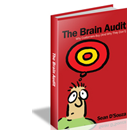You’ve been told that FREE works really well.
Well it does
But only when attracting a customer.
If you really want a customer to benefit, you have to stop the free dole out.
Because the moment something continues to be free, the consumption of those products/services plummets like a rock.
You don’t have to believe me, but you might as well. Because we’ve tried this concept several times over.
So let’s take a real case study
We used to have free marketing courses at a cafe and we called it ‘BizBrew.’ Each of the Biz Brew courses were complete in every detail. It was the kind of course that you’d readily pay $75-$100 for, without the coffee. I say, without the coffee, because the coffee brewed up a latte, a frappe, or just about any coffee you wanted. And yes, it was free.
Think about it: A free course. Free coffee. And a pretty decent presenter. Would you miss sessions?
You’re shaking your head thinking there’s no way you’d miss it, but the converse is true. When given a free option, people turn up sporadically, and then not at all. In fact, we were so sure we were wrong about this concept, that we started a new course series called the ‘Learning Rock’.
While every session of the ‘Learning Rock’ was full, they were filled with 60% of new customers. Only 40% of the customers were repeat customers.*
Then we had paid courses. And 95% turned up for every course. Without fail. Come rain or shine.
So what does this teach you about consumption?
That the concept of FREE is wonderful for attracting customers. That FREE forms a beautiful attraction factor. But it’s only the first step in the sequence of attraction, conversion and consumption. Once a customer has gone through the attversumption steps; once they’ve opted in for the FREE whatever, and consumed the FREE product/service, the next step should be paid.
And that if you truly want to help your customers, you must make them pay.
* Note
We’ve tried this FREE model both online and offline. We’ve tried it both for products and services. We’ve tried it once, twice, thrice, hoping somehow we were wrong in our assessment. And no matter what options, media or method we tried, FREE always failed at consumption stage.
It’s not like a paid product/service works 100% of the time. Even when a customer pays, they are not always consuming the product/service. However, the consumption factor is far, far greater when the product/service is paid for—and especially if paid for in advance.
—————

“What do your customers think? What would make them buy?”
In the Brain Audit – Sean teaches 7 steps on how to form killer communication pieces that makes people buy from you. The Brain Audit is a simple psychological system that everyone can use in their communication to increase their profits.”
Ankesh Kothari – Biztactics, USA
Judge for yourself
Read how The Brain Audit can help you…
———————
“When I went to 5000BC it sort of looked like a lot of the same information that was on Pyschotactics.”
The only real difference I saw was that 5000BC had a forum. I just couldn't get past the price tag for what seemed like I was getting for free. At first I just didn't get it. Then you kept talking about all the great stuff in 5000BC in your newsletters and I thought I'd give it a try to see what it was really about.
What I found was there was more to it than I thought. That there were resources and articles that I wasn't getting at Psychotactics. And that Sean was there – not just running the site but THERE for anyone who needed help
I see so many people who just don't know where to start when they are marketing – they are all over the board trying things and none of those things seem to work. Mainly because they aren't focused. 5000BC can help hone that focus.

Cathy Graham, Owner/Designer
Grafix Unlimited, Memphis, TN, USA
Judge for yourself https://www.psychotactics.com/5000bc
———————
Products: Under $50
1) Do You Often Hit A Wall Called ‘Writers Block'?
Learn how the core elements of outlining can save you from the misery of writing your next article.
2) Do you know that visuals immediately improve your sales conversion?
Learn how to create drama and curiosity and help improve your web page conversion with visuals.
3) Do your websites, brochures, presentations, etc… confuse your clients?
Put some sanity into your design, even though you are not a designer?
4) Chaos Planning
Year after year you sit down and create a list of things you want to achieve. Then suddenly it's March, and you've not really moved ahead as you'd expected.
Learn Why Most Planning Fails: And The Critical Importance of Chaos in Planning.
5) Nothing bugs you more than a painful client.
A client who hassles you at every step of the way. Learn how to use the power of the ‘six critical questions' to get incredible testimonials—and attract clients that make every day an absolute joy.
[next_step]


Something that costs nothing is worth exactly that — nothing!
I couldn’t disagree more. I’m reposting my comment from Jurgen’s post:
I have another theory: probably many more people are a little bit interested than are interested enough to pay. When you’re a little bit interested, it’s easy to sign up and give something a go. But if you pay for it, you’re more likely very interested and will therefore finish.
The number that is missing from your article here is how many people went to the free course vs the paid one. If 100 people go for free, and 40 of them stay until it’s complete, it might compare with 43 people who go, paid, and 40 people stay until it’s complete. Without knowing the numbers, I’d put my two cent bet on the latter.
@Terry: right now you can get great literature for free at Gutenberg.org for your Kindle or other eBook device. Are you saying Shakespeare, since his plays are free, are worth nothing?